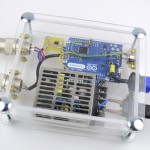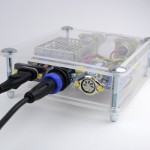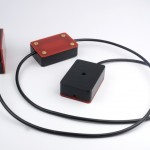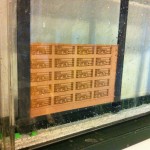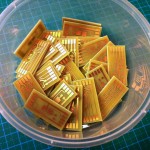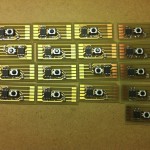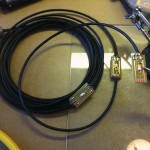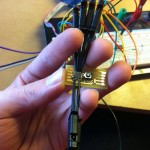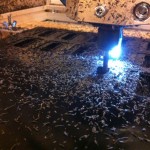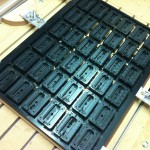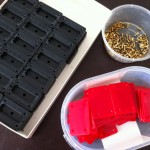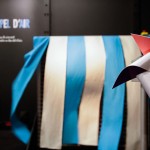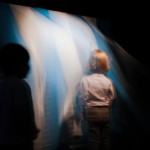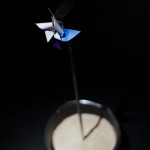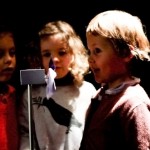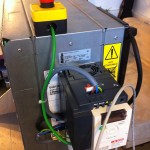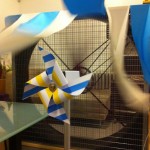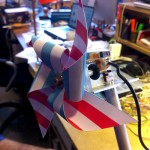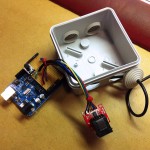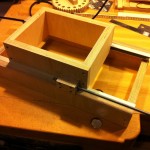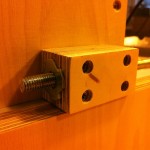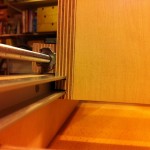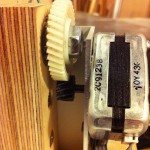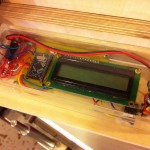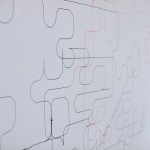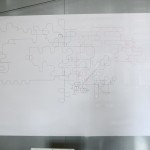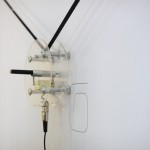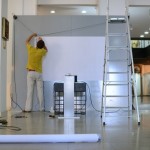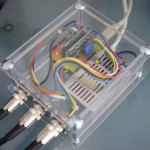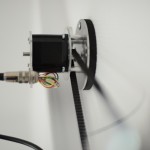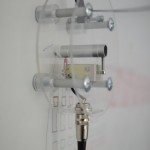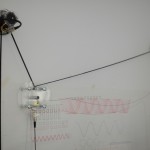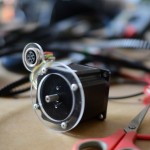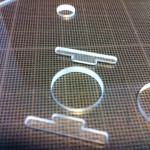About 4 years ago, I build this first version of Up for the FICAM festival in Meknes (Morocco). As I am more and more asked to exhibit this installation, I decided to rebuild it in a more robust and reliable way. This new version was shown for the first time in Paris at Forum des Images for the Tout petits Cinéma festival 2013.
Basically each step of a staircase is equipped with an infrared emitter and an ir receiver. When someone is putting his foot down on a step the ir beam is stopped and the receiver sends its new status to the main controller box. This box generates MIDI signals that can be played by any type of MIDI synth.
I completely revisited the technical aspect of the project: while in the first version, each of the 16 receivers sent their status through a dedicated wire (which ends up in quite a big cable in the end), now they each embed a small microcontroller (Attiny 45) and are daisy chained. This means that each sensor is sending its data over the SPI protocol to the next one until it has reached the main controller (Arduino). With this design, I ended up with only one 5-wires cable linking the sensors together.
Other improvements of this version are : solid plastic cases for the emitters and sensors, nice enclosing box for the main controller and better MIDI integration.
Anyone interested in exhibiting this installation for an event ? Contact lab212.
Some pictures of the build process:
16/04/2013 | In Artistic, Electronics, Manufacturing | Tags : arduino, attiny, ir, midi
Lab212 were asked to design an exhibition for young children (2 to 4 years old) at Stereolux in Nantes. I worked with Pierre on his idea. Basically it’s a huge industrial fan that responds to your blow on a tiny pinwheel. It’s not a simple on/off interaction, the big fan reproduces exactly the same speed curve the user applied to the pinwheel.
I primarily worked on the technical aspect of the project. The big challenge was to drive the Altivar 3 phase frequency controller with an Arduino. I had a hard time to study the MODBUS / RS485 protocols and the Altivar documentation about MODBUS communication isn’t very DIY’er friendly…
The speed of the pinwheel is measured with an old ball mouse mechanism that sends it’s PS2 data to the Arduino (this part was easy thanks to all the libraries that exist). The Arduino on the other hand outputs the fan speed data through an RS233 – RS485 transceiver connected to the speed controller via an RJ45 cable. The Altivar also delivers enough power through the RJ45 connector to feed the Arduino and mouse board so we ended up with rather clean setup.
A dedicated website shows all the projects of this exhibition and you can read more about Appel d’air on Pierre’s website.
08/01/2013 | In Artistic, Electronics, Programming | Tags : altivar, arduino, exhibition, mechanics, modbus
Some weeks ago I equipped my workshop with a very good table saw (from the Austrian manufacturer Felder) and since I discovered this great website and in particular this jig, I just had to build my own. Due to my experience with stepper motors, I decided to use one of them grabbed from a scanner in combination with an easyDriver and an Arduino (an old mini I had left). I tried to keep the design as simple as possible without making use of some special hardware but the precision of the whole thing is quite good: about 0.03 mm.
I put the Arduino code here and the schematics for the board I built is here.
22/06/2012 | In Electronics, Manufacturing, Programming | Tags : arduino, mechanics, woodworking
Au delà de 1 m/s (Beyond 1 m/s) is an art installation from Albertine Meunier materializing the speed of the Internet. Every 30 seconds Google is asked for the last results of the keywords “je pense” (I think), the machine then rise one marble per result. The device is autonomous and directly connected to the Internet through an Arduino Ethernet.
More on this project here : www.albertinemeunier.net/au-dela-de-1m-s/
and thanks to woodgears.ca for his very inspiring Marble Machine (among a lot of other stuff…)
07/06/2012 | In Artistic, Electronics, Manufacturing, Programming | Tags : arduino, mechanics, wood
My last project with Milk for the NES brand. I programmed the led animations around the machine. Made with kikko and 21h42.
30/04/2012 | In Commercial, Electronics, Programming | Tags : arduino, flash, paris
This project is a piece for the exhibition Circuler at the Cité de l’architecture in Paris. It was designed by Catherine Ramus at Orange labs. I worked on the lamps modifications and the integration of the projectors. An Arduino is used to simulate the clicks of the projectors’s remote controls to launch the videos when the whole piece is switched on.
More in this video starting at 2:30.
18/04/2012 | In Artistic, Electronics, Manufacturing | Tags : arduino, mapping, paris
This is my first attempt to use the Taos TCS3200 light to frequency converter. It’s the first step of my research for the next version of Stop-iT. More about this project coming soon…
The breakout board I made to be able to test this sensor:

13/02/2012 | In Electronics, Experimental | Tags : arduino, light sensor, stop-it
Quelques images de DM02 installée à Belgrade au musée de l’Ethnologie. Le manque de signalétique et d’organisation a limité le passage : le dessin est loin d’être aussi rempli que prévu…
22/07/2011 | In Artistic, Electronics, Experimental, Manufacturing, News, Programming | Tags : arduino, belgrade, cocoa, dm02, exhibition, mechanics
Test de dessin génératif codé avec un module d’interprétation Javascript intégré au logiciel de pilotage de DM02.
16/06/2011 | In Artistic, Electronics, Experimental, Manufacturing, Programming | Tags : arduino, cocoa, dm02, mechanics
Voici les premiers essais de dessins de ma nouvelle drawing machine. Comparée à DM01, celle-ci est beaucoup plus légère à installer : pas de câbles à tendre, seulement deux modules à fixer au mur. Un mécanisme permet de lever l’outil de dessin et la précision est améliorée. Les deux moteurs pas à pas sont pilotés par un Arduino associé à des contrôleurs LitleStepU. Un logiciel développé sous Cocoa permet d’envoyer les instructions de dessin à l’interface électronique.
Pour le moment, DM02 est plutôt conçu comme un outil pouvant servir dans différentes installations interactives.
06/06/2011 | In Artistic, Electronics, Experimental, Manufacturing, Programming | Tags : arduino, cocoa, dm02, mechanics

